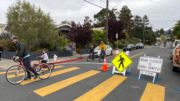Editor’s note: Sacramento County is backsliding in effort to reopen more businesses
Everyone is focused on Election Day, and for good reason. But it shouldn’t go unnoticed: Sacramento County’s COVID-19 recovery has stalled.
It took the county a month to get out of the most restrictive purple tier. Since Sept. 29, the county has been stuck in the red tier, which allows some non-essential businesses to resume limited indoor operations. It missed a goal to reach the orange tier by Halloween—and instead it’s backsliding.
On Wednesday, the state Department of Public Health put the county at 7.4 new daily cases per 100,000 people and a 3.4% positive rate on tests.
For the second week in a row, those numbers are worse than the previous week. On Oct. 27, the county was at 5.7 new cases per day per 100,000 people and a 2.8% test positivity rate. And on Oct. 20, the numbers were 4.4 new cases per day and a 2.5% test positivity rate countywide.
To move from red to orange on the state Blueprint for a Safer Economy, the benchmarks are fewer than 4 new cases a day, plus a test positivity rate below 5%. A county must meet the benchmarks for two weeks in a row, so the soonest Sacramento could reach the orange tier is Nov. 17.
And if its new case rate stays above 7, the limit for the red tier, for a second week, Sacramento County is in danger of going backwards to the most restrictive red tier.
Public Health reported 159 new cases on Tuesday, a rate of 10.2; 235 on Wednesday, a rate of 15.1; and 252 on Thursday, a rate of 16.2. UPDATE: On Monday, the agency reported 707 more cases Friday-Sunday, a daily rate of 15.2 per 100,000.
On Tuesday, county public health officials told the Board of Supervisors that cases are increasing, though not as much as the surges in the Midwest and Great Plains. Late last week, the U.S. set all-time records for new daily cases as we head into what experts warn could be a deadly winter.
Because private gatherings are a main cause, county officials said there will be public relations campaign for COVID safety during Thanksgiving and the holidays, urging a one-year break from extended family traveling from elsewhere and gathering indoors.
“That’s just a formula for transmission,” said Public Health Officer Olivia Kasirye.
Health Services Director Peter Beilenson also told supervisors that with repeated noncompliance with safety rules, officials are moving toward fining businesses.
Officials also said that to continue testing in 2021, they need more money, particularly from the federal government. Supervisor Don Nottoli said it’s absolutely essential to keep county testing sites open to reopen more of the economy.
Otherwise, he said, “we’ll be stuck. That’s no good for anyone.”
Meanwhile, Public Health is streamlining and automating its contact tracing to make it quicker and less expensive. It allows the department to contact individuals who have tested positive for COVID-19 and anonymously notify those they have been in contact with.
The new system, plus three years of support services, will cost $1.6 million but is expected to save money over time because fewer investigators will be needed. The county says it is also looking at adding a portal for schools and businesses to submit contacts into the system. Contact tracing is crucial to stop any coronavirus clusters from spreading. It’s even more important as people spend more time indoors as the weather gets colder.
Yet, there’s growing local resistance to continuing the lockdown among residents and some elected officials.
On Tuesday, angry constituents again called on supervisors to end the state of emergency. One caller said the county is becoming like “Red China” or “Nazi Germany.” “A virtual Thanksgiving? Are you f—–g kidding me?” she said.
Supervisor Sue Frost said Tuesday that the economic damage is catastrophic and urged public health officials to find ways to reopen businesses more quickly.
“We’re shutting down productivity,” she told her colleagues. “We can’t keep going down this path forever.”
Frost continues to call on the state to allow parts of counties with lower case numbers to reopen sooner. She, Folsom Mayor Sarah Aquino and others point out that neighboring El Dorado County has been in orange for several weeks and that El Dorado Hills is taking business away from Folsom.
Beilenson, however, told Frost that the zip code strategy is “questionable.” “It’s a difficult situation,” he said.
The county, he said, needs to stay the course to control the deadliest pandemic in a century until a vaccine becomes widely available next year.
Supervisor Patrick Kennedy thanked officials for resisting pressure and putting public health first. And Supervisor Phil Serna said the county will continue to follow the science and listen to the public health experts. He said he’s offended by some of the critics, especially when he has had a family member die from the coronavirus.
“It’s better to live with it,” he said, “than die with it.”






Be the first to comment on "Sacramento languishing in COVID limbo"